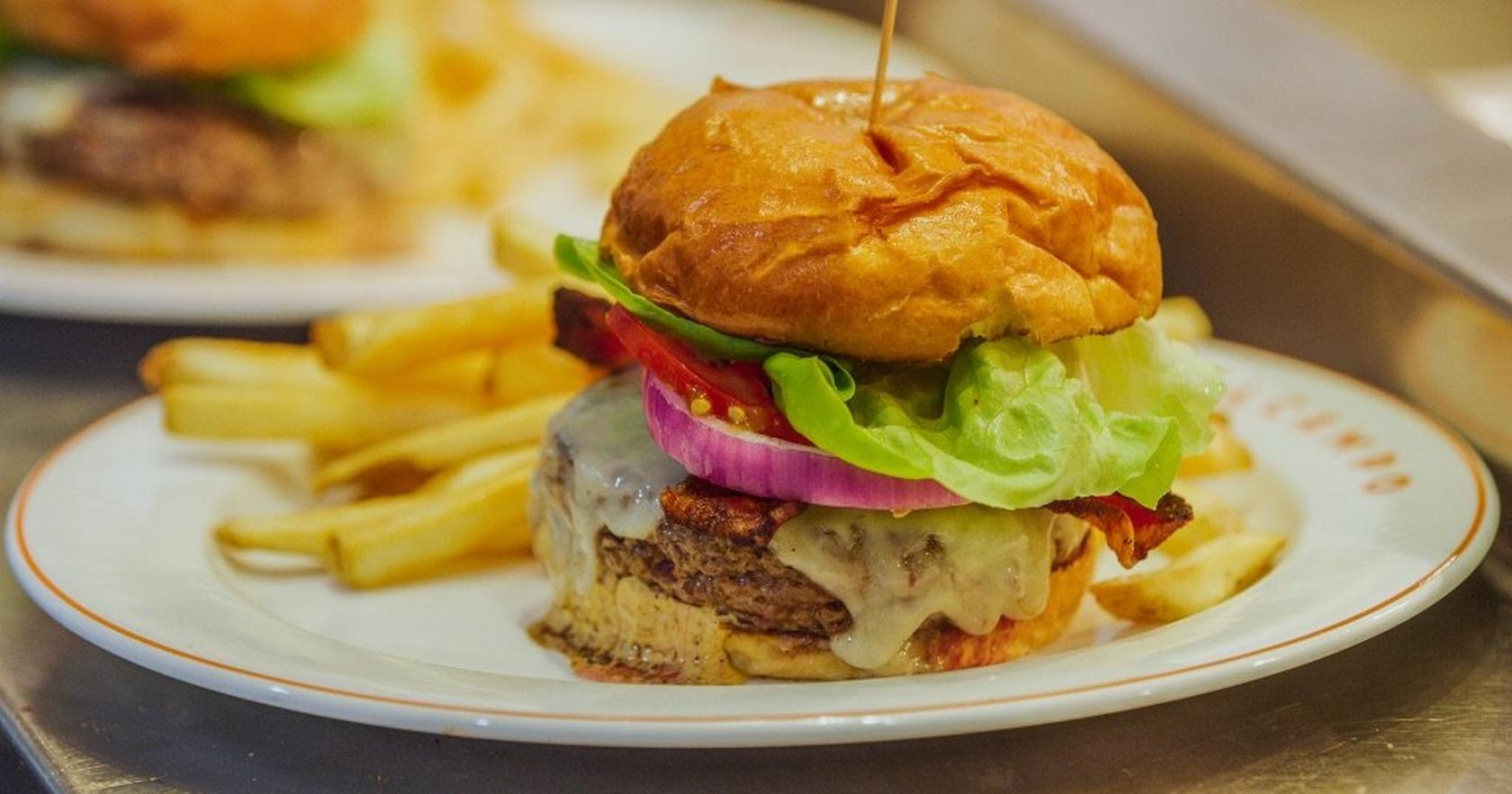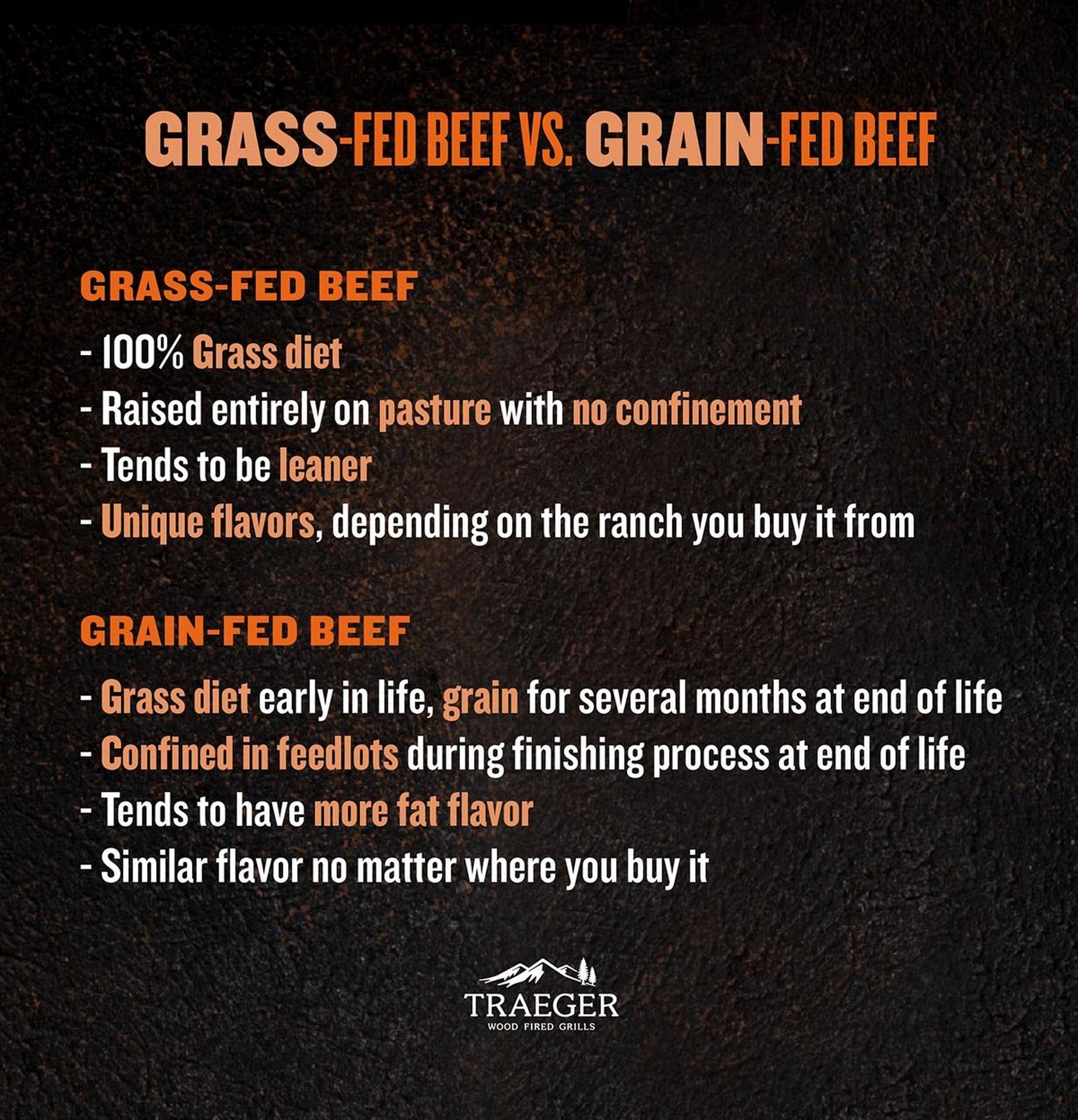
The concept of grass-fed beef seems simple enough, but you may be surprised to learn some of the details. We're going to explain what “grass-fed” actually means, and give you some tips for cooking this throwback style of beef.
What Is Grass-Fed Beef?
Grass-fed beef refers to beef from cattle that eat grass for their entire lives. But the term is also used to encompass animal welfare and health practices that some consider to be healthier for the animals, humans, and the environment as a whole.
According to Belcampo Meat Co. co-founder and Traeger user Anya Fernald, animals raised in natural, outdoor conditions taste better, have a positive environmental impact and are better for your health.
There is no official U.S. government definition of grass-fed beef. But the American Grassfed Association, which certifies meat producers with the American Grassfed label, has these four requirements for beef and other meat products to be considered grass-fed.
- 100% grass diet
- Raised on pasture (no confinement)
- No antibiotics or hormones
- Family farm origin
Grass-Fed Beef vs. Grain-Fed Beef
All beef cattle spend most of their lives eating grass in pastures. The difference between grass-fed beef and grain-fed beef comes at the end of the animal's approximately 2-year lifespan.
Grain-fed cattle eat grass at the start of their lives, but at the end, they go through a finishing process of approximately 5 to 6 months, or about 25% of the animal's life. The finishing process increases the animal's weight, and thus the amount of meat the producer can sell.
During this time, the cattle are shipped to feedlots where they consume a diet that is high in grains (usually corn) to fatten them. They may also be given growth hormones for the same reason. The animals are confined to a smaller space, and may be given antibiotics to protect them from infections. Approximately 95% of U.S. cattle are grain-fed.
Pure grass-fed cattle live on pastures and eat grass for their entire lives. They don't go to feedlots or eat manufactured grain feed.
Because of the difference in diet, there are slight differences in the chemical composition, nutritional content, and flavor of grass-fed and grain-fed beef.
Grass-fed beef tends to be leaner than grain-fed beef with less fat flavor. Some people interpret grass-fed beef to have a gamey or meaty flavor.
According to a study by Texas A&M University, grass-fed beef is higher in omega-3 fatty acids than grain-fed beef, while grain-fed beef is higher in oleic acid. Both are considered important nutrients in human diets.
Researchers from Frontiers in Nutrition note that humans can benefit from a diet rich in natural compounds. Animals raised eating only grass, rather than manufactured grain-rich feed, may provide meat with more of these natural compounds.
Grass-Fed vs. Grass-Finished Beef
Because 100% grass-fed cattle don't get the blast of grain-heavy feed at the end of their lives, they tend to be smaller and take longer to fully mature for sale. One way to increase the amount of meat on grass-fed animals is to give them a high-grain diet for a short period of time before sale. Producers can do this and still label the meat grass-fed.
However, when you see meat labeled grass-finished (also known as pasture-finished), the producer is telling you that the animal stayed on a grass diet for its entire life.
What Are the Benefits of Grass-Fed Beef?
Because certified producers of grass-fed cattle are committed to raising the animals in a more natural way, they don't use hormones to increase the animals' weight. They also avoid the use of antibiotics.
Raising grass-fed beef requires active management of pasture which may have environmental benefits, primarily for the biodiversity of pasture ecosystems and the overall soil health.
Is Grass-Fed Beef Better for You?
The best person to answer the question of whether grass-fed beef is better for you is your doctor. Everyone's dietary needs are different. Grass-fed beef is higher in certain healthy compounds than grain-fed beef, but the reverse is also true.
If the animal welfare and biodiversity practices of grass-fed beef producers are important to you, this may be a consideration as well.

Where to Buy Grass-Fed Beef
The American Grassfed Association maintains a map of certified producers including contact information. If you want, you can go right to the source to see how the animals are fed and raised.
Grass-fed beef is for sale at many supermarkets and farmers markets.
Not all producers who call their meat grass-fed are certified, however. There is no official standard for what constitutes grass-fed, so you're trusting what the producer says.
If you want more information, talk to the butcher where you buy your meat. At the farmers market, you can talk directly with the producer themselves and ask about their finishing process.
How to Cook Grass-Fed Beef
Any recipe that calls for beef can be cooked the same way with grass-fed beef as with the more common grain-fed variety.
However, there are some slight differences between the two that you might want to take into account.
Grass-Fed Cuts Are Leaner
Grass-fed beef cuts tend to be leaner than the grain-fed versions of the same cuts. A grass-fed ribeye isn't likely to have the same amount of fat marbling as a grain-fed ribeye.
So if you are cooking a grass-fed beef steak you may want to consider using an acidic marinade to help make the meat slightly more tender. You would also want to be even more careful than usual to avoid overcooking since the lean meat will toughen up faster.
If you are cooking a stew with grass-fed beef, you want to make sure you have plenty of moisture in the final dish because the beef might be a little dry due to the lack of fat.
Grass-Fed Cuts Have Unique Flavor
The flavor of grain-fed beef tends to be uniform since feedlots give a similar, manufactured grain mixture to thousands of cattle at a time. The consistency of flavor is something grain-fed producers strive for.
You can buy a grain-fed steak at a supermarket in Seattle, and it should taste about the same as a grain-fed steak from a supermarket in El Paso -- the same way fast-food chain hamburgers will taste the same in both places.
Grass-fed beef tends to have more unique flavors than grain-fed beef. Different producers feed their cattle different grasses based on what grows well in their region, or what they think will make for tasty beef. So the flavors of grass-fed beef can be different depending on the grass that the cattle were eating.
And because a grass-fed animal doesn't get the infusion of grain-based feed, grass-fed beef has less fat. It's the fat that provides a lot of the flavor.
Those who do taste a difference in the flavor of grass-fed beef sometimes like it, and sometimes don't. People who prefer the flavor of grass-fed beef often say it tastes meatier and earthy. People who object to the flavor of grass-fed beef often say it tastes gamey, or they simply feel it has less flavor.
Our recommendation is to pick a local producer at a farmers market or grocery store, and cook some of their grass-fed beef. If you like the flavor, great! If not, try the grass-fed beef from another ranch.
If you want to tone down the gamey flavor of grass-fed beef, you can try marinating it in buttermilk. The buttermilk tenderizes the meat slightly and can give it a brighter, tangier flavor. Marinate refrigerated for at least 30 minutes, but no more than 24 hours.
Grass-Fed or Grain-Fed, Add Your Own Flavors on a Traeger
Another way to experiment with the flavor of either type of beef is to use the natural smoke generated by a wood pellet grill. Smoke from all-natural mesquite wood pellets, along with the natural-pastured flavors of grass-fed beef, are a classic combination that would be at home on an old-time cattle drive.
The temperature settings and smoking capabilities of your Traeger make it easy to experiment with new flavors like those of grass-fed beef.
Grass-fed Beef Burgers
by Anya Fernald
6 Reviews
Prep Time
10 Min
Cook Time
30 Min
Serves
4
Pellets
Hickory
Anya Fernald, founder and CEO of Belcampo Meat Co., knows a thing or two about beef and shows us how burgers are done with her go-to burger recipe. Juicy grass-fed patties are cooked hot and fast, topped with melty Provolone, and sandwiched between buttery brioche buns.
Ingredients
main
| 2 Pound | grass-fed ground beef |
| 4 Teaspoon | kosher salt |
| 4 Slices | provolone cheese |
| 4 | brioche burger buns |
| Toppings of choice, for serving |
1
When ready to cook, set the Traeger temperature to 415°F and preheat, lid closed for 15 minutes.
2
Divide the ground beef into 4 portions. Gently shape each portion into a patty about 5 inches across. Do not overwork the meat. Sprinkle 1/2 teaspoon of salt on each side of the patties.
3
Place the hamburgers directly on the grill grates. Insert the probe horizontally into one of the patties. Close the lid and cook, flipping once, until the meat is nicely browned and the internal temperature reaches 130°F for medium-rare, about 12 minutes, or your desired temperature. During the last few minutes of cooking, top each patty with a slice of Provolone cheese and place the buns, cut-sides down, on the grill to toast.
4
Place the patties on the toasted buns and top with a slice of tomato and your favorite toppings and condiments. Enjoy!